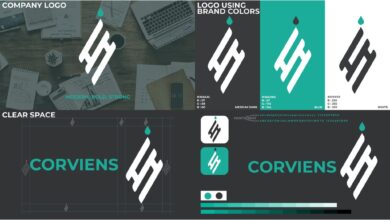
Is Your Brand Due for a Refresh?
Is your brand due for a refresh? Feeling a little…stale? Maybe your logo looks like it belongs in a museum, or your messaging feels outdated. A brand refresh isn’t just about a new logo; it’s about reconnecting with your audience and ensuring your brand remains relevant, vibrant, and competitive in today’s ever-evolving market. Ignoring the signs can lead to declining customer engagement and lost market share – a situation no business wants to find itself in.
This post will explore the key indicators that signal a brand refresh is necessary, guide you through the process of analyzing your current brand perception, help you define a new brand identity that resonates with your target audience, and provide a step-by-step plan for implementing and measuring the success of your revitalized brand. We’ll cover everything from understanding customer sentiment to creating a compelling visual identity and rolling out the changes across all your platforms.
Get ready to breathe new life into your brand!
Signs Your Brand Needs a Refresh

Source: inc.com
Is your brand feeling a little…stale? Like that forgotten sweater at the back of your closet? A brand refresh isn’t about throwing everything out; it’s about revitalizing what’s there, making it relevant and exciting for your target audience once more. Ignoring the signs can have serious consequences, so let’s dive into the key indicators that suggest your brand needs a makeover.
Five Key Indicators Requiring Brand Revitalization
Recognizing the need for a brand refresh is crucial for maintaining a competitive edge and sustaining customer loyalty. Ignoring these signals can lead to declining market share, reduced customer engagement, and ultimately, brand irrelevance. Here are five critical signs your brand needs a boost:
- Declining Sales and Market Share: A consistent downward trend in sales figures, coupled with a shrinking market share, strongly suggests a disconnect between your brand and your target audience. This could indicate a need for updated messaging, product offerings, or overall brand positioning.
- Negative Online Reviews and Social Media Sentiment: A flood of negative feedback online, expressing dissatisfaction with your products, services, or customer service, is a major red flag. This reflects a growing perception problem that requires immediate attention and strategic adjustments.
- Outdated Brand Identity: A logo, color palette, and overall aesthetic that feel dated or out of sync with current design trends can make your brand appear less appealing and trustworthy to modern consumers. This visual disconnect can hinder brand recognition and appeal.
- Loss of Brand Relevance: If your brand message no longer resonates with your target audience, or if your products and services no longer meet their evolving needs, your brand may be losing its relevance. This often manifests as declining engagement and a shrinking customer base.
- Increased Competitor Success: While competition is inevitable, a significant surge in a competitor’s success, particularly if they are offering similar products or services, can indicate that your brand is falling behind. This requires a thorough analysis of your competitive landscape and a strategic response.
Consequences of Ignoring Brand Revitalization Indicators
Ignoring these warning signs can lead to a downward spiral. A brand stuck in the past risks losing its connection with its audience, failing to attract new customers, and ultimately becoming irrelevant. This can translate to significant financial losses, damage to brand reputation, and a struggle to compete in a dynamic marketplace. For example, imagine a clothing brand that continues to use outdated styles and marketing strategies while competitors embrace modern trends and digital platforms.
The result could be dwindling sales, a shrinking customer base, and a damaged brand image.
Is your brand feeling a little stale? A fresh coat of paint might be just what it needs! Consider boosting your brand visibility by exploring new avenues, like learning how to effectively leverage video marketing; check out this great guide on getting it on with youtube to see how. Ultimately, a refreshed brand image, coupled with a strong YouTube presence, can revitalize your connection with your audience.
Impact of Brand Refresh on Customer Loyalty Versus Stagnant Brand Identity
A brand refresh, when executed effectively, can significantly enhance customer loyalty. By updating your brand’s visual identity, messaging, and overall experience, you can re-engage existing customers and attract new ones. This renewed sense of relevance and excitement can foster stronger customer relationships and increase brand advocacy. In contrast, maintaining a stagnant brand identity can lead to customer apathy, decreased engagement, and ultimately, a loss of loyalty.
Customers may perceive the brand as outdated, uninspired, and unresponsive to their evolving needs.
Hypothetical Scenario Illustrating Negative Effects of Neglecting a Brand Refresh
Imagine “Classic Cameras,” a company specializing in film photography. For years, they’ve relied on their established brand identity, featuring a retro logo and marketing primarily through print media. However, the rise of digital photography and social media has dramatically altered the market. Classic Cameras fails to adapt, ignoring the declining sales and negative online comments about their outdated marketing and lack of online presence.
Competitors offering both film and digital options, coupled with vibrant social media campaigns, rapidly gain market share. Classic Cameras eventually struggles to remain profitable, its brand image tarnished by its inability to evolve with the changing times. This scenario illustrates the dire consequences of ignoring the clear signals that a brand refresh is urgently needed.
Analyzing Current Brand Perception
Understanding your current brand perception is crucial before undertaking a refresh. A misaligned brand image can lead to wasted resources and ineffective marketing. By accurately assessing how your customers view your brand, you can identify areas needing improvement and tailor your refresh strategy for maximum impact. This analysis allows for a more strategic and effective rebranding process, ultimately leading to stronger customer relationships and increased brand loyalty.
Methods for Gauging Current Customer Perception
Several methods can provide valuable insights into how customers perceive your brand. Gathering this data allows for a data-driven approach to the brand refresh, ensuring that the changes resonate with your target audience. Ignoring this step can lead to a rebrand that fails to connect with your customers.
- Customer Surveys: Directly ask your customers about their experiences and opinions through surveys. Use a mix of quantitative (rating scales, multiple-choice questions) and qualitative (open-ended questions) questions to get a comprehensive understanding. For example, you could ask questions like “How would you describe our brand in three words?” or “What is your overall satisfaction with our products/services?”.
Analyzing the responses will reveal key themes and areas for improvement.
- Social Media Monitoring: Actively track mentions of your brand across social media platforms. Look for both positive and negative comments, reviews, and discussions. Pay attention to the language used and the overall sentiment expressed. This provides real-time feedback on your brand’s reputation and allows for quick responses to address concerns.
- Focus Groups: Organize small group discussions with representative customers. Facilitate a conversation around your brand, its image, and its competitors. This qualitative method allows for in-depth exploration of customer perceptions and can uncover unexpected insights. The insights gained can be invaluable in shaping your brand refresh strategy.
Social Media Sentiment Analysis
Social media sentiment analysis involves using technology to automatically analyze the emotional tone of online conversations related to your brand. This goes beyond simple monitoring; it uses natural language processing (NLP) and machine learning to identify the sentiment (positive, negative, or neutral) expressed in social media posts, reviews, and comments. This analysis can reveal trends, pinpoint specific areas of concern, and even track the effectiveness of your brand refresh efforts over time.
For instance, a spike in negative sentiment after a rebranding initiative could indicate that adjustments are needed.
Comparative Competitor Branding Analysis
Analyzing your competitors’ branding strategies is essential for identifying opportunities for differentiation. This involves researching their brand messaging, visual identity, target audience, and overall market positioning. Understanding what makes them successful and where they fall short can help you define your unique selling proposition (USP) and refine your brand refresh strategy. For example, if your competitors focus on a luxury image while you aim for affordability, you can leverage this difference in your marketing.
Current Brand Image Analysis
A structured analysis of your current brand image highlights its strengths and weaknesses, guiding the refresh process. This comparative approach, focusing on specific aspects of your brand, enables a more focused and effective rebranding effort.
| Aspect | Current Strength | Current Weakness | Improvement Opportunity |
|---|---|---|---|
| Brand Messaging | Clearly communicates core values to a niche audience. | Messaging is inconsistent across different platforms. | Develop a unified brand voice and messaging guide. |
| Visual Identity | Logo is recognizable and memorable. | Color palette feels outdated and lacks vibrancy. | Update the color palette and visual elements to reflect current design trends. |
| Customer Service | Fast response times to customer inquiries. | Lack of personalization in customer interactions. | Implement a CRM system to personalize communication and improve customer relationships. |
| Product Quality | High-quality materials and craftsmanship. | Limited product variety and innovation. | Expand product offerings and introduce innovative features to appeal to a broader audience. |
Defining the New Brand Identity
Revitalizing a brand isn’t just about a new logo; it’s about crafting a compelling narrative that resonates with your target audience. This involves defining a clear mission, choosing a brand personality that aligns with your goals, and creating a visual identity that embodies that personality. Let’s delve into the process of defining your refreshed brand identity.
This section will focus on creating a concise brand mission statement, exploring three distinct brand personality options, analyzing their impact on target audience engagement, and finally, visualizing the chosen brand personality through a detailed description of its visual representation.
Brand Mission Statement, Is your brand due for a refresh
Our refreshed brand mission will be: “To empower individuals through innovative solutions, fostering a community of connection and growth.” This statement encapsulates our commitment to both product innovation and building a strong relationship with our users. It’s concise, memorable, and reflects our core values.
Brand Personality Options
We’ve identified three distinct brand personality options, each with its own strengths and implications for target audience engagement:
- Option 1: The Friendly Expert: This personality is approachable, knowledgeable, and trustworthy. Think a helpful neighbor who also happens to be a leading expert in their field. The communication style would be warm, informative, and reassuring. Imagery would feature smiling faces, friendly interactions, and perhaps a subtly vintage aesthetic to suggest established expertise.
- Option 2: The Bold Innovator: This personality is forward-thinking, daring, and creative. It projects confidence and a willingness to push boundaries. The communication style would be bold, energetic, and inspiring. Imagery would feature vibrant colors, dynamic lines, and cutting-edge technology.
- Option 3: The Minimalist Minimalist: This personality is sophisticated, clean, and efficient. It values simplicity, clarity, and functionality. The communication style would be direct, concise, and elegant. Imagery would be clean, uncluttered, and feature a limited color palette, likely neutrals with a single accent color.
Implications of Brand Personality on Target Audience Engagement
The choice of brand personality directly impacts how our target audience perceives and interacts with the brand.
- The Friendly Expert resonates with audiences seeking trust and reliability. It fosters loyalty and encourages repeat business.
- The Bold Innovator appeals to audiences seeking excitement and novelty. It can attract new customers and build a reputation for being at the forefront of the industry. However, it might alienate customers who prefer a more traditional approach.
- The Minimalist Minimalist attracts audiences who value simplicity and efficiency. It projects an image of sophistication and high quality, but might be perceived as cold or impersonal by some.
Chosen Brand Personality and Visual Representation
For our refreshed brand, we’ve chosen The Friendly Expert personality. This aligns with our commitment to providing reliable, high-quality solutions while building a strong community around our brand.
The visual representation will incorporate:
- Color Palette: Warm, earthy tones such as muted greens, soft blues, and creamy beige, accented with a warm, inviting orange. This palette evokes feelings of trust, approachability, and warmth.
- Font: A clean, legible serif font like Garamond or Georgia for headings, paired with a sans-serif font like Open Sans or Lato for body text. This combination provides a balance of sophistication and readability.
- Imagery: Photographs featuring diverse people collaborating, working together, and smiling. The images will be authentic and un-staged, conveying a sense of genuine connection and community. We might also incorporate subtle illustrative elements to add a touch of personality and warmth.
Implementing the Brand Refresh
Successfully launching a refreshed brand isn’t just about creating a new logo; it’s about a strategic, phased rollout that ensures consistent messaging and a seamless transition for your audience. A well-executed plan minimizes disruption and maximizes the impact of your brand refresh. This involves a coordinated effort across all departments and platforms.The implementation phase is crucial. A poorly executed rollout can undermine even the most thoughtfully designed brand refresh, leading to confusion and potentially damaging your brand equity.
Therefore, a meticulous, step-by-step approach is essential to ensure a smooth and effective transition.
Step-by-Step Rollout Plan
A successful brand refresh requires a well-defined plan. This plan should detail the sequence of changes, timelines, and responsibilities for each team involved. Consider prioritizing high-visibility platforms first to create immediate impact.
- Internal Communication: Begin by educating your internal teams about the refreshed brand. This ensures everyone understands the changes and can consistently represent the new brand identity.
- Website Update: Update your website with the new logo, color palette, typography, and imagery. This is often the first point of contact for many customers.
- Social Media Refresh: Update your social media profiles with the new branding. This includes profile pictures, cover photos, and consistent use of the new brand voice and style.
- Marketing Materials Update: Gradually update existing marketing materials, prioritizing high-impact items like brochures, presentations, and email templates. Consider phasing out older materials over time to avoid confusion.
- Packaging and Merchandise: If applicable, update product packaging and merchandise with the refreshed brand identity. This might require a longer lead time due to production processes.
- Employee Training: Train employees on the new brand guidelines and ensure they understand how to use the updated brand assets consistently.
- Monitoring and Feedback: Continuously monitor customer and employee feedback to identify any issues or areas for improvement in the implementation process.
Examples of Successful Brand Refresh Campaigns
Many companies have successfully refreshed their brands. For example, Starbucks’ 2011 logo redesign simplified their siren logo, giving it a more modern and minimalist look, which reflected a shift towards a more streamlined and premium brand image. Similarly, Pepsi’s 2008 refresh modernized their logo and introduced a new global design language, aiming for a more youthful and dynamic appeal.
These successful campaigns were characterized by thorough planning, consistent messaging, and a focus on maintaining brand essence while modernizing its visual identity.
Integrating the New Brand Identity into Existing Marketing Materials
Integrating the new brand identity requires a systematic approach. Start by identifying all existing marketing materials, such as brochures, flyers, presentations, and email templates. Prioritize updating high-impact materials first. When updating, focus on consistency in color palette, typography, and imagery. Consider creating new templates that reflect the refreshed brand guidelines.
This ensures that all future marketing materials align with the updated brand identity. Phased implementation, with clear timelines, minimizes disruption.
Brand Refresh Checklist
Thorough planning is key to a successful brand refresh. Here’s a checklist to guide the process:
- Conduct a thorough brand audit.
- Define your target audience and their needs.
- Develop a new brand strategy and guidelines.
- Create new brand assets (logo, color palette, typography).
- Update website and social media profiles.
- Update marketing materials.
- Train employees on the new brand guidelines.
- Monitor customer feedback and make adjustments as needed.
Measuring the Success of the Refresh

Source: yourmarketinglady.com
A brand refresh is a significant investment, so it’s crucial to measure its effectiveness. Simply implementing changes isn’t enough; you need concrete data to demonstrate the return on investment and inform future marketing strategies. Tracking key performance indicators (KPIs) and actively monitoring customer feedback are vital for understanding the impact of your refresh and making necessary adjustments.Successfully measuring the success of your brand refresh involves a multifaceted approach.
This includes identifying and tracking relevant KPIs, actively soliciting and analyzing customer feedback, and comparing pre- and post-refresh brand perception data. Finally, maintaining brand consistency after the refresh is crucial for sustaining the positive impact.
Key Performance Indicators (KPIs) for Brand Refresh Success
To accurately gauge the success of your brand refresh, focusing on specific, measurable KPIs is essential. These metrics provide quantifiable data to assess the impact of your changes. Using a combination of quantitative and qualitative data paints a complete picture of the refresh’s success.
- Website Traffic and Engagement: Increased website traffic, longer session durations, and higher conversion rates (e.g., purchases, sign-ups) indicate a positive response to the refreshed brand. For example, a 20% increase in website traffic after a brand refresh, coupled with a 15% rise in conversion rates, would suggest a successful implementation.
- Social Media Engagement: Monitor metrics such as follower growth, likes, shares, comments, and mentions. A surge in positive social media engagement suggests the refreshed brand resonates with your target audience. For instance, a 30% increase in followers and a 40% increase in positive mentions on social media platforms could be a strong indicator of success.
- Brand Awareness and Sentiment: Conduct surveys and brand tracking studies to measure changes in brand awareness and sentiment (positive, negative, or neutral). A rise in positive brand sentiment and increased brand recall demonstrate the effectiveness of the refresh. For example, a pre-refresh brand awareness score of 30% rising to 45% post-refresh, accompanied by a shift from 20% negative sentiment to 10%, indicates a successful brand refresh.
Monitoring Customer Feedback and Adapting Strategy
Gathering and analyzing customer feedback is critical for understanding how the refreshed brand is perceived. This provides valuable insights that can guide further improvements and adjustments to your strategy.Various methods can be employed to collect customer feedback, including surveys, social media monitoring, focus groups, and customer service interactions. Analyzing this feedback allows for identification of areas where the refresh has been successful and areas needing improvement.
For instance, if customer feedback consistently highlights confusion regarding a new logo, adjustments might be needed to improve its clarity and memorability. This iterative process of collecting feedback, analyzing it, and adapting the strategy ensures the brand refresh remains effective and relevant.
Comparing Pre- and Post-Refresh Brand Perception Metrics
Direct comparison of brand perception metrics before and after the refresh provides a clear picture of the impact. This involves tracking key aspects of brand perception, such as brand awareness, brand trust, and brand preference. Analyzing the changes in these metrics reveals the effectiveness of the refresh in achieving its intended goals.For example, you could compare customer survey results before and after the refresh to assess changes in brand awareness, customer satisfaction, and purchase intent.
By quantifying these changes, you can determine the overall success of the brand refresh and identify areas for improvement.
Maintaining Brand Consistency After the Refresh
Maintaining brand consistency after the refresh is crucial for sustaining the positive impact. This involves implementing a robust brand management system that ensures consistent application of the refreshed brand guidelines across all touchpoints.A comprehensive brand style guide, regular training for employees, and consistent monitoring of brand usage across all channels are vital for maintaining consistency. Failure to maintain consistency can undermine the effectiveness of the refresh and lead to brand confusion among customers.
For instance, inconsistent use of the refreshed logo across different marketing materials can dilute its impact and create a fragmented brand image.
Final Review
Revitalizing your brand isn’t a one-time fix; it’s an ongoing process of adaptation and evolution. By regularly assessing your brand’s health, actively listening to your customers, and staying ahead of industry trends, you can ensure your brand remains strong, relevant, and connected to your audience for years to come. Remember, a successful brand refresh is more than just a cosmetic change; it’s a strategic investment in your business’s future.
So, take a look at your brand – is it ready for its close-up, or is it time for a makeover?
Questions Often Asked: Is Your Brand Due For A Refresh
What’s the difference between a brand refresh and a rebrand?
A brand refresh typically involves updating elements like your logo, color palette, and messaging while maintaining the core essence of your brand. A rebrand is a more significant overhaul, often involving a complete change of name, logo, and brand identity.
How much does a brand refresh cost?
The cost varies greatly depending on the scope of the project and the agencies or freelancers you hire. Expect to invest a significant amount, but remember it’s an investment in your long-term success.
How long does a brand refresh take?
The timeline depends on the complexity of the project. Expect anywhere from a few months to a year, depending on your needs and resources.
Do I need a professional to help with a brand refresh?
While you can DIY a refresh, professional help is highly recommended, especially for larger brands or complex projects. A professional can provide valuable expertise and ensure a cohesive and effective refresh.





